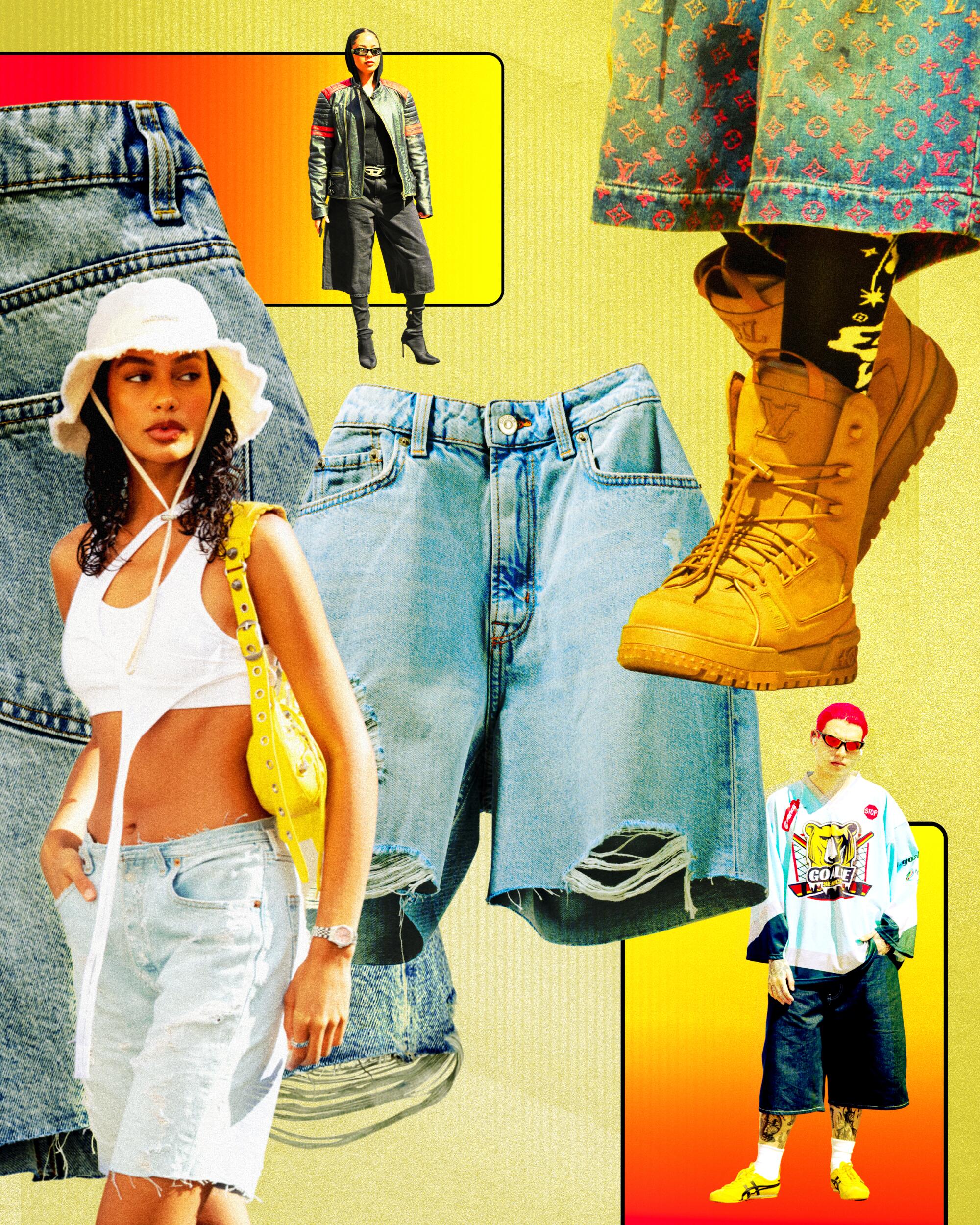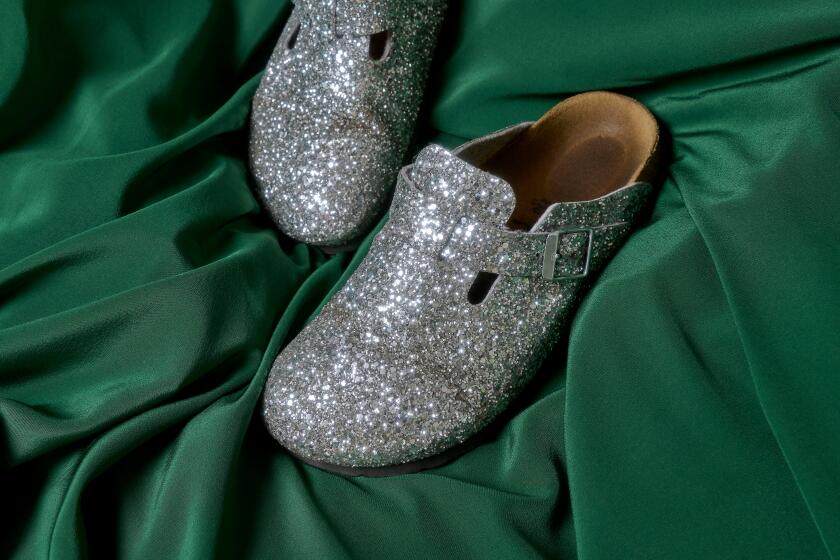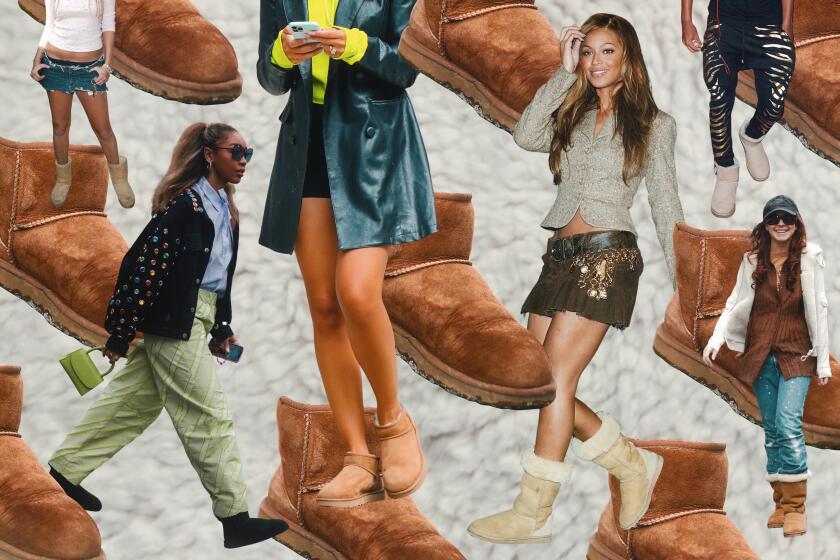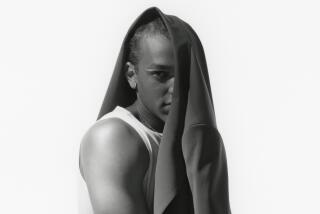- Share via

This story is part of “Discourse,” a fresh look at the dire state of the bicoastal conversation — free from corniness and cliches. Check out the whole issue — the “New York” issue, if you’re reading between the lines — here.
Jorts are not what they seem: jeans cut down into shorts. A Frankenstein object hacked and trimmed to serve a new purpose. Who jorts have been claimed by — punk rockers, pop stars and rappers, the squarest middle-aged men on weekends — is simply the narrative sewn on top of the real narrative. There’s something inherently rebellious about jorts because they transmogrify jeans, making them skimpier, sexier and, in some cases, snugger. They take a staple material for clothing, denim, known for its durability and utility — Gold Rush prospectors needed pants that could withstand a day spent on one’s knees pawing through the mud looking for buried treasure — and expose its insides. Jorts demystify. And yet their appeal remains somewhat of a mystery. They always seem to find themselves back on the runway eventually, simulating a middle finger to the gods of couture and good taste.
In the wild, jorts look tacky and cheap — something better left to Miller Lite-soaked lakeside barbecues or a vacation episode of “Vanderpump Rules” on which James calls Tom Schwartz “grandpa.” I can’t imagine ever owning another pair myself. Jorts were something I could reasonably wear during junior high, which is exactly the time in pop culture when they were most socially acceptable.
The Venn diagram of comfort and swag is nearly a single circle now. Boston mules — fabulously comfortable shoes beloved by well-dressed people who prefer walking over driving — are at the forefront of the vibe shift.
I most associate jorts with the fashions of the 2000s, a time when hip-hop gods like Nelly and Lil Jon would wear billowing denim shorts that often hung perilously close to the pubic region. In the case of Mr. Jon, the inseam of these monstrosities would be so substantial that they barely qualified as shorts to the rational observer. If the bottom of your shorts reach your ankles, are they pants? Imagine these circus tents entering the always contentious inseam debates of the 2020s. It would be absolute chaos.
As horrific as these oversize jorts might have been, they’re the epitome of the genre. I don’t think of the cheek-hugging Daisy Dukes popularized by their namesake or Mariah Carey or the shredded beachy ones that you’ll see on Justin Bieber. For better or worse, I am a child of the era when jorts were made to fit an entire Arizona Iced Tea can that may or may not have been illicitly swiped from a 7-Eleven fridge.
In a city known for flipping the switch and letting the void do its thing, embracing darkness in your closet might be the sartorial special time you’ve been looking for.
I mean, the John Cena jorts. He might not have invented the baggy jean shorts and jersey look, but, like the Tony Yayo Dance, he ended up becoming synonymous with it. Cena is a major movie star now, but back in 2002, he was a pro wrestler hoping to make a name for himself in a difficult business. He invented a character who rapped on his way to the ring, insulting his opponent’s sexual prowess, parentage or horrible breath. In order to better portray a hip-hop wrestler, Cena started wearing jorts to the ring. And then, inexplicably, wrestling in them. He looked like the one white guy invited to be an extra in a Jagged Edge music video.
As the 2000s wrapped up and the hip-hop aesthetic moved from elephantine jean shorts and Air Force 1s, Cena’s character became a more generic good guy in a colorful T-shirt. But he kept the jorts. On the rare occasion when Cena wrestles today, he’ll be in jorts. I won’t be so bold as to say that Cena is the one primarily responsible for keeping the trend alive during the fallow years, but he certainly didn’t hurt the cause.
Jorts have ridden the wave of 2000s nostalgia that brought back Uggs, but it’s not that simple. Because jorts are not just the thing I remember being appalled by as a kid. They’re not a singular, trademarked product like Uggs. One can create a pair of jorts at home, with nothing more than some jeans and a pair of scissors. I’ve heard countless stories from friends of the anxiety that comes from mutilating a piece of clothing, hoping that the finished product doesn’t look atrocious. Jorts can be customized, remixed and reconsidered. You can decide how long the inseam is, whether the pockets are showing and even the color.
The early 2000s saw celebutantes like Lindsay Lohan and Paris Hilton rocking their Uggs to Starbucks runs and lunches. Now, the ‘can’t be bothered’ boot is back.
Sure, all of these things can be found in a commercially available, off-the-rack pair of jean shorts. The jorts resurgence is being hypercharged by big brands like Givenchy and cutting-edge designers like Marine Serre doing their luxury take on an item that feels downmarket. They can put sparkles and double-knee paneling on them, manufacture them in a variety of colors and even put cargo pockets on the sides. But the thrill of the jort is in the making — in the duality of creation and destruction that comes from hacking up your pants.
It’s a reconnection with youth. It’s also a kiki with bad taste — a concept that is in short supply the older you get. People expect adults to have it together, to know the answers to every style question. Kids, on the other hand, have no concept of taste and are allowed to do whatever they want, whenever they want. You’re allowed to make mistakes. And sometimes, those mistakes become fashion trends. Adolescence is a time when you can’t afford to buy new clothes all the time.
Granted, maybe you still can’t. It’s 2023, after all. But jorts could be a means of self-expression or a gateway into DIY craftiness. If you want, they can be a project. They can tell a story. They define your social circle, from skater kids to good ol’ country boys. Jorts take something universal like denim and make it idiosyncratic and one-of-a-kind. Just like John Cena turned jorts into his trademark by daring to wear them during a wrestling match, you can make them your own through craft and time and effort. To revamp a popular phrase from the heyday of hip-hop jorts, they are not just for you. They’re also by you.







